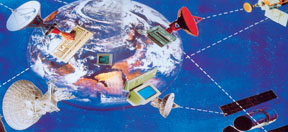
Satellites around the Earth
We introduced you to satellites in our previous article on June 25.
Today, we'll tell you more on them. We'll start with what is inside a
typical satellite.
Satellites come in all shapes and sizes and play a variety of roles.
For example:
* Weather satellites help meteorologists predict the weather or see
what's happening at the moment. The satellites generally contain cameras
that can return photos of the Earth's weather, either from fixed
geostationary positions or from polar orbits.

* Communications satellites allow telephone and data conversations to
be relayed through the satellite. Typical communications satellites
include Telstar and Intelsat. The most important feature of a
communications satellite is the transponder - a radio that receives a
conversation at one frequency and then amplifies (increases in volume)
it and retransmits it back to the Earth on another frequency.
A satellite normally contains hundreds or thousands of transponders.
Communications satellites are usually geosynchronous.
* Broadcast satellites broadcast television signals from one point to
another (similar to communications satellites).
* Scientific satellites perform a variety of scientific missions. The
Hubble Space Telescope is the most famous scientific satellite, but
there are many others looking at everything from sun spots to gamma
rays.
* Navigational satellites help ships and planes navigate. The most
famous are the GPS NAVSTAR satellites.
* Rescue satellites respond to radio distress signals.
* Earth observation satellites observe the planet for changes in
everything from temperature to forestation to ice-sheet coverage. The
most famous are the LANDSAT series.
* Military satellites are up there, but much of the actual
application information remains secret.
* All of them have a metal or composite frame and body, usually known
as the Bus. The Bus holds everything together in space, and provides
enough strength to survive the launch.
* All of them have a source of power (usually solar cells) and
batteries for storage. Arrays of solar cells provide power to charge
rechargeable batteries. Newer designs include the use of fuel cells.
Power on most satellites is precious and very limited. Nuclear power has
been used on space probes to other planets. Power systems are constantly
monitored, and data on power and all other on board systems is sent to
Earth stations in the form of telemetry signals.
* All of them have an on board computer to control and monitor the
different systems.
* All of them have a radio system and antenna. At the very least,
most satellites have a radio transmitter or receiver, so that the
ground-control crew can request status information from the satellite
and monitor its health. Many satellites can be controlled in various
ways from the ground to do anything from change the orbit to reprogram
the computer system.
All of them have an attitude control system (ACS), which keeps the
satellite pointed in the right direction. The Hubble Space Telescope has
a very elaborate control system so that the telescope can point at the
same position in space for hours or days at a time (despite the fact
that the telescope travels at 17,000 mph/27,359 kph!). The system
contains gyroscopes (rotating device which keeps navigation instruments
steady), accelerometers, a reaction wheel stabilisation system,
thrusters and a set of sensors that watch guide stars to determine
position.
Satellite Launch Window
A launch window is a particular period of time in which it will be
easier to place the satellite in the orbit necessary to perform its
intended function.
With the space shuttle, an extremely important factor in choosing the
launch window is the need to bring down the astronauts safely, if
something goes wrong. The astronauts must be able to reach a safe
landing area where rescue personnel can be standing by. For other types
of flights, including inter-planetary exploration, the launch window
must permit the flight to take the most efficient course to its very
distant destination.
If weather is bad or a malfunction occurs during a launch window, the
flight must be postponed until the next launch window appropriate for
the flight. If a satellite were launched at the wrong time of the day in
perfect weather, the satellite could end up in an orbit that would not
pass over any of its intended users. |


